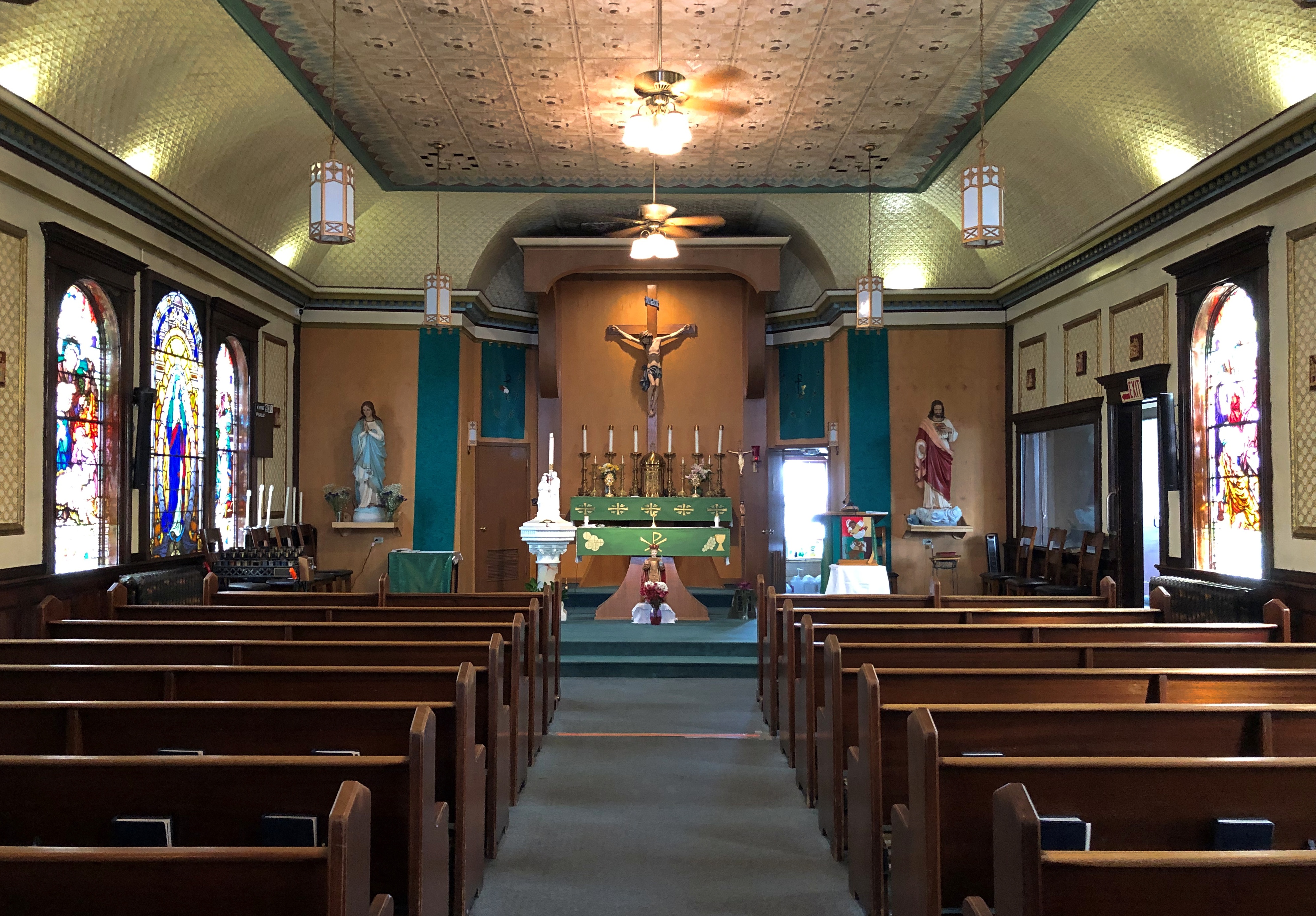On the Chena River across from Fairbank’s Golden Heart Plaza is Immaculate Conception Church, built by Father Francis Monroe, S.J. early in the city’s history (1904) south of the river, but moved to its present position (north of the river) across the frozen Chena in the winter of 1911-12. Modern moving techniques weren’t available, so townspeople were taking bets as to whether the building would actually make it across.
The view of downtown from the church.
Immaculate Conception is the oldest Catholic church in the interior of Alaska, and at one time counted as a cathedral. That title and the seat of the Diocese of Fairbanks is elsewhere these days, at Sacred Heart Cathedral, which I drove by but didn’t stop at.
I was glad to find the church open.


That was the only Fairbanks church I ventured inside of, but I did stop for a look at a few other exteriors, such as First United Methodist, just outside downtown.

The more modernist First Presbyterian, not far from city hall.

And the Episcopalian St. Matthew’s, founded in 1904.
“St. Matthews is one of the three oldest churches in Fairbanks, located on First Avenue, across the street from the Chena River,” the church web site says. (South of the river.) The view of the Chena at that point:
“The original church building burned in 1947, but the great wooden altar and other carvings were saved, and were replaced with the present St. Matthew’s Church building. First services in the new church were held Christmas Eve, 1948. Its congregation numbers about 1,200, over half of which are Alaskan Native. The Lord’s Prayer is prayed nearly every Sunday (if a speaker is present) in the Gwitch’in, the Athabaskan language, as well as in English.”
The church also has a deep and unexpected (to me, anyway) connection with the first ascent of Mt. Denali. The Episcopal Archdeacon of Alaska and the Yukon, Hudson Stuck, held the first service at St. Matthew’s on October 16, 1904.
Less than nine years later, in the spring of 1913, Stuck led the first expedition to summit Denali, or McKinley, as it was known at the time. Three other men were with him: “Walter Harper, the youngest at age twenty, half Alaskan Native, fit and confident; Harry Karstens, thirty-four, calmly competent from his years in the Alaskan backcountry; and Robert Tatum, twenty-one, the greenest member of the team,” the Daily Beast notes.
The final push came on June 7. “They had launched this expedition eight weeks earlier, enduring bitter cold, severe altitude, and the loss of key supplies to a campfire…
“How did an Episcopal Archdeacon, well into middle age by the standards of the time, come to find himself in the freezing final summit push on the highest, coldest peak on the continent? The answer lay in two equally potent forces, woven into his being. Just as strong as Hudson Stuck’s belief in doing good — “I am sorry for a life in which there is no usefulness to others,” he once wrote — was his love of wild places.
“For Stuck, Alaska was a place where his physical and spiritual aspirations, his goals for himself and for his mission, could be united into a single purpose. ‘I would rather climb Mount McKinley than own the richest gold mine in Alaska,’ he claimed. He was not alone in his desire.”
A fascinating tale about someone I’d never heard of. Stuck was not, however, the first to the summit that day. He tapped Walter Harper for that honor.
“Harper was born in late 1892 and was the son of a Koyukon-Athabascan mother, Seentaána, and a legendary gold prospector father, Arthur Harper,” the NPS says.
“Walter was raised by his mother and was fluent in Koyukon-Athabascan. Tanana was his home village and he eventually attended the Saint Mark’s Mission school in Nenana before becoming a guide for Missionary Hudson Stuck. Stuck’s faith in Harper as a skilled guide and outdoorsman eventually led to his participation in the Denali summit expedition.”
Harper might well have become an important figure in the Alaska Territory, but he had the great misfortune to be aboard the Princess Sophia in October 1918, which sank en route from Skagway to Vancouver after striking Vanderbilt Reef, with the loss of all 350-plus souls — another story I’d never heard.



